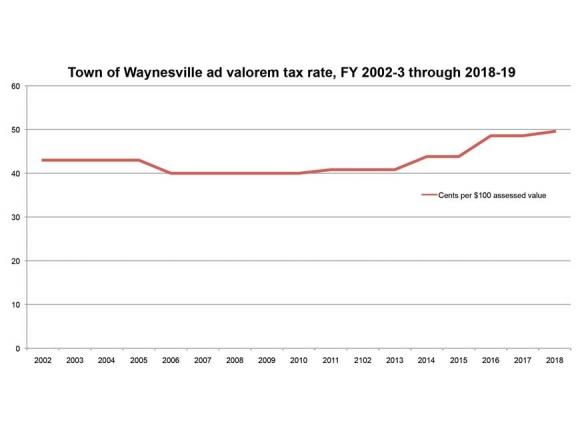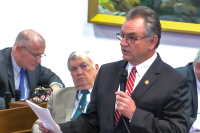Waynesville budget gumbo could be hard to swallow

Property owners, single-family homebuilders and any Waynesville residents who own a car will see their cost of living increase over the next year, under a FY 2018-19 budget passed June 26 that includes an eclectic mix of charges in the form of both tax and fee increases.
“It is a substantial increase, with the 1-cent tax increase, the motor vehicle tax,” said Waynesville Mayor Gavin Brown. “We’ve increased some of the revenues in our proprietary funds by 5 percent, but I think looking down the road, we’re just trying to take care of business.”
Amidst rising costs and flat revenues, the increases balance a budget that is 7.1 percent bigger than last year’s, even though pre-recession annual revenue growth of 7 percent is long gone.
The property tax increase is the town’s second in three years and third in five years; in 2014, the town’s 40.82 cents per $100 assessed valuation went up to 43.82 cents for two years. A year later, in 2016, that climbed to 48.57 cents, largely due to the addition of eight new firefighter positions to ensure OSHA compliance. After remaining the same last year, the tax rate was again upped to 49.57 cents for the 2018-19 budget year.
The property tax increase will allow the town to add three new positions — one in the garage, one in the recreation department and one in the planning department, which in an encouraging sign has seen a “significant” increase in incoming workloads, according to Town Manager Rob Hites.
Also significantly increasing is the town’s health insurance premium, which will grow by 6 percent, or about $207,000. For perspective, 1 cent of property tax at the current rate yields about $115,000 in revenue.
Related Items
An electric rate hike of 5 percent in early January will be joined by an additional 4 percent hike as of Aug. 1, to bring the fund back into balance with rate hikes by provider Santee Cooper; the enterprise fund serving 3,000 Waynesville customers had been operating at a small loss, absorbing $200,000 last year.
Water rates won’t change, but the cost of joining the system will.
Capacity use fee
A bill that made it through the General Assembly in 2017 in response to a lawsuit from Moore County developers changed the fundamental nature of how North Carolina towns will amass the monies needed to fund costly water and sewer improvements far into the future.
Under the old policy, new customers wanting to tap in to town water and sewer services were charged by the size of their water meters and water lines.
House Bill 436 changed that standard to the gallon and required towns to conduct a study to determine the value of the existing system capacity.
Now customers are charged more fairly according to the current value of system capacity they’ll utilize, in essence paying the town back at fair market value for their tiny fractional impacts on the system.
A McGill and Associates report established a maximum rate for the town’s $43 million system, of which the town elected to charge less than half, while also evening out billing inequities, encouraging larger-scale developments and helping save for the future.
With a ceiling of $5.23 for water and $7.23 for sewer, the town set water at $2.62 and sewer at $3.05. Those dollar figures are all measured in average gallons per day of projected system utilization by intended purpose of the parcel. Laundromats, for example, are projected to use 500 gallons of sewer capacity per machine per day, while bars use 20 gallons per seat.
Accordingly, rates vary widely between the old plan and the new plan. For starters, aldermen did away with higher rates for out-of-town customers.
Although a typical three-bedroom home within town limits would have incurred $1,300 in connection fees under the old plan, that now jumps 57 percent to $2,041. However, the same three-bedroom home outside of town limits that would have been charged $2,600 is now charged that same $2,041 as a home in town.
A larger, 384-bedroom development that would have cost $135,200 under the old plan could have seen the cost skyrocket to $200,000 but for a $100,000 cap on fees also included in the new plan, which could be a boon to both multi-unit residential and high-capacity commercial development; a 75,000 square-foot generic commercial development with almost $75,000 in connection fees under the old plan will now see savings of almost $20,000.
Vehicle fee
Also included in the budget is a semi-controversial $15 vehicle registration tax, which was passed separately and unanimously by town aldermen just prior to the budget, over minor public opposition.
While municipalities in North Carolina have had the option to levy such a tax since 1986, only Maggie Valley had availed itself of the opportunity to date, charging $5 per year since passing a proposal in 2015.
Statute allows municipalities to use the first $5 of the tax for any lawful purpose; the next $5 must go to the town’s public transportation system, if it has one, but from there, the everything else, up to $30, must be used for road improvements.
Waynesville doesn’t have a public transportation system, and has pledged to put the first $5 toward the police department. The rest, nearly $100,000, will go to things like pothole repair and small-scale patching projects.
Some in the public, however, weren’t willing to give the tax a green light.
“You are asking us, Mr. Hites, to spread the burden of that $15 tax to pave the streets. You have the money in your general fund. You get money from our taxes, our property taxes,” said Waynesville resident Mary Roper, who quickly shifted her ire to the Board of Aldermen.
“It is not right,” added Roper, who’d also spoke against the tax at the previous town board meeting June 12. “If you have any empathy for anybody that has to bear the $15 just for the town, because we’re not the only ones that drive these streets — you have the trucks, you have the visitors, you have all of Haywood County — you can find another way to get that money.”
Unfortunately, dwindling revenue sources and decreased Powell Bill funding leave many small North Carolina towns with few other options for road maintenance, a fact all too clear to aldermen.
“What we are doing is planning for a way to take care of those streets, because I’ll tell you who ain’t gonna help us, and that’s the State of North Carolina,” said Brown. “They have cut and cut and cut, leaving municipalities to take care of business, and that’s fine, but at some point, we’re going to have to pay for it.”
Alderman Dr. LeRoy Roberson spoke of the tax as a bitter pill, but one that would ultimately pave the road to recovery for the town’s ailing streets.
“I’m not happy with it, and I’d like to see a way around it,” he said, “but if you’ve ever had your tired aligned it costs a lot more than $15. Replacing your tire is going to be more than that. The state has seen to it that our Powell Bill [funding] has been cut, and we just don’t receive the funding that we used to.”
Research commissioned by Alderman Jon Feichter and conducted by Finance Director Eddie Caldwell shows that from FY 2007-08 through FY 2013-14, Powell Bill funding decreased by more than 20 percent to just short of $330,000. Although it has inched up since then, it’s still not close to what it had been in the past, according to Feichter.
“But we are still tasked with maintaining more miles and sidewalks than ever before,” he said. “I am all for doing more for less, but at some point ‘less’ becomes ‘not enough.’”
Professed 20-something year veteran of the Waynesville Town Board Gary Caldwell said he’d seen firsthand what Feichter was talking about.
“I don’t like it either but I don’t see any other way out of this,” he said of the 85 miles of streets that the town monitors.
“Our entire staff has agonized over this budget,” said Alderman Julia Boyd Freeman. “Looking, and finding and cutting areas so we can fund the services and the repairs that are so needed for our community — it’s just not there anymore.”
The relative ease with which the measure passed in Waynesville lies in glaring contrast to the Town of Canton just 12 miles distant, where a similar proposal for a $30 fee — all going toward streets — was decried by more than 20 people in two separate public meetings before being voted down unanimously by Canton’s Town Board two days after the Waynesville meeting (see Roadblock, page 14).
“I actually talked with young Zeb Smathers down in Canton,” Brown said. “It’s difficult to allocate the costs of maintenance of streets, and this is just one way of trying to do it equitably. I didn’t say it was perfect.”
Waynesville’s vehicle tax is estimated to raise $147,000 this year, per town records. That amount is approximately equivalent to what a 1.27-cent property tax increase would have raised for this year’s $34 million all-funds budget.
Property taxes in Waynesville remain near the low to middle range of other Haywood County municipalities, compared to Canton’s 58 cents, Clyde’s 45 cents and Maggie Valley’s 45 cents.









